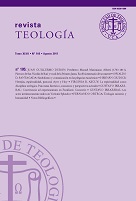Convivencia ad experimentum en Familiaris Consortio
Keywords:
Premarital sex, Familiaris Consortio, Veritatis Splendor, “Pedagogical” argument, Intentional structure, Chastity, CorporealityAbstract
The author analyzes the phenomenon of sexual relations between boyfriends and girlfriends or fiancées, that is, in the context of a shared pro- ject that is oriented toward marriage. As a starting point he presents a situation analysis which considers a variety of factors that have facilita- ted the spread of this phenomenon, a great impact in the last twenty years in Western societies. Among the factors, discussed is the delay in the completion of marriage and the transformation of the vision of sexua- lity in the frame between the public and private, and lists the various cir- cumstances that affect them, in order to raise arguments that affirm the illegality of sex before marriage even in the cases referred. In this sense the author first analyses the “pedagogical” argument and outlines its fai- lure to establish in an unquestionable way the wrongfulness of these rela- tionships. Next he deliberates in the intentional dimension raising the question of whether the relationships that seek to be an expression of mutual love, are able to transmit it and whether they are objectively sui- ted to it. The author continues to analyze the intentional structure of premarital sex, which is distinguished from the conjugal act in view of FC, and how it is integrated into a Christian theological vision. Finally, he presents the difficulties and challenges of such a perspective for the couple and the value of an education in love that highlights the paschal significance of the human body.Downloads
Download data is not yet available.
Downloads
Published
03/25/2020
How to Cite
Irrazábal, G. (2020). Convivencia ad experimentum en Familiaris Consortio. Teología, 48(105), 281–290. Retrieved from http://202239.1xw36.group/index.php/TEO/article/view/2243
Issue
Section
Articles
License
Copyright (c) 2020 Teología

This work is licensed under a Creative Commons Attribution-NonCommercial-ShareAlike 4.0 International License.














 Teología
Teología